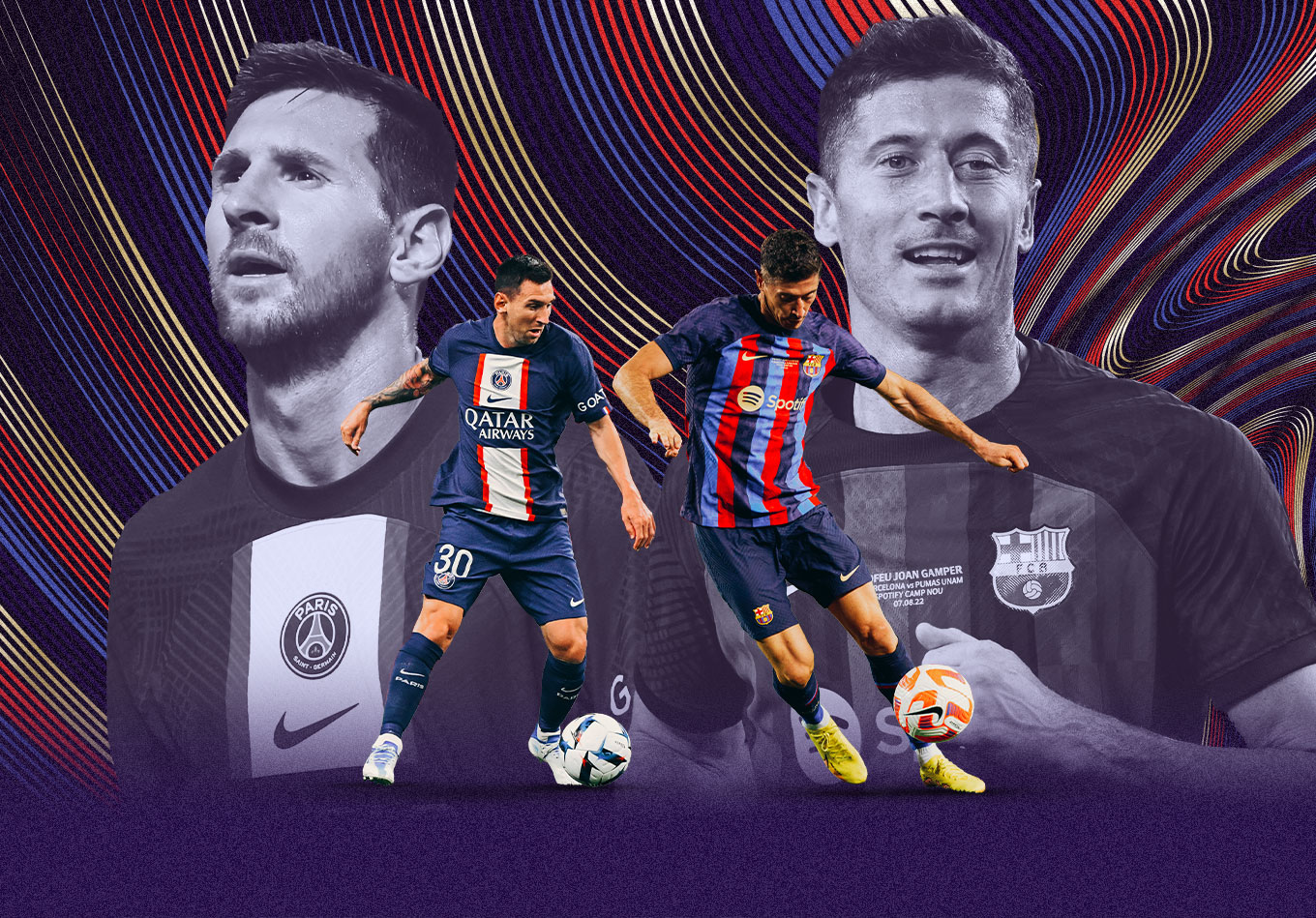For Barcelona, the post-Messi era has been the messiest of their modern history. The Catalan giants ended 2021 over £1 billion in debt and come into 2022-23 off the back of their worst season in almost two decades. While they finished second behind arch-nemeses Real Madrid, Barça posted their lowest La Liga points total (73) since 2007-08 (67) and failed to advance from the Champions League group stage for the first time since their current 18-year qualifying streak began in 2004.
But Xavi’s appointment as manager last November led to a marked improvement on the pitch (his predecessor in the Camp Nou dugout, fellow Blaugrana icon Ronald Koeman, had set the five-time European champions on a seemingly troubled course). Xavi’s welcome return was inevitable – as were the comparisons with Pep Guardiola which immediately followed. The 42-year-old – a metronomic presence at the heart of Guardiola’s all-conquering Barça team –has insisted that he “[doesn’t] have the idea of equalling” his former boss – but he has gone and equalled him this transfer window by signing one of the best out-and-out No. 9s in world football.
After eight years spearheading Bayern Munich’s domestic dominance, Robert Lewandowski has left behind the ultra-fertile goalscoring ground of the Bundesliga for a new challenge: making hay in the not insignificantly less arable Spanish top flight. Assuming his new club are able to register him, the petrifyingly prolific Pole will be the main man in Barça’s latest new-look front three.
Messi’s dramatic departure last summer was precipitated by chaos off the pitch – and it was always going to spark a certain degree of chaos on it. Sure, Barça could have done a lot worse than Memphis Depay as the new focal point of their attack – the Dutchman scored 12 La Liga goals at a rate of 0.58 per 90 last season – but the club’s craving to restore their status as one of the continent’s biggest hitters demands that they do better. When a Koeman side featuring a Cruyff-eschewing front two of Depay and Luuk de Jong – a bona fide target man – went down 3-0 away to Benfica in the Champions League at the end of September (after being utterly outclassed in losing by the same scoreline to Bayern in their previous group match), ‘nadir’ was the only word for it.
The February acquisition of Pierre-Emerick Aubameyang following his acrimonious exit from Arsenal proved to be something of a masterstroke – the former Premier League Golden Boot recipient struck 11 times in his first 17 La Liga outings – but a Barcelona team without an elite centre-forward just felt… wrong. And it would appear that those inside the hallowed walls of the (Spotify) Camp Nou shared the sentiment: the most prolific striker in Europe became available (Lewandowski announced his intention to leave Bayern back in May) and Barça pounced.
So, all being well, Barça should begin the campaign deploying an elite true No. 9 for the first time since 2009 – when Pedro and Bojan lined up on either side of Zlatan Ibrahimović (who claimed he was “sacrificed” later that season so Messi could reprise his false nine role). But will Lewandowski be able to replicate his extraordinary Bundesliga scoring form (he’s averaged better than a goal per 90 in four of the last five campaigns) in what is statistically the second-toughest division on Earth?
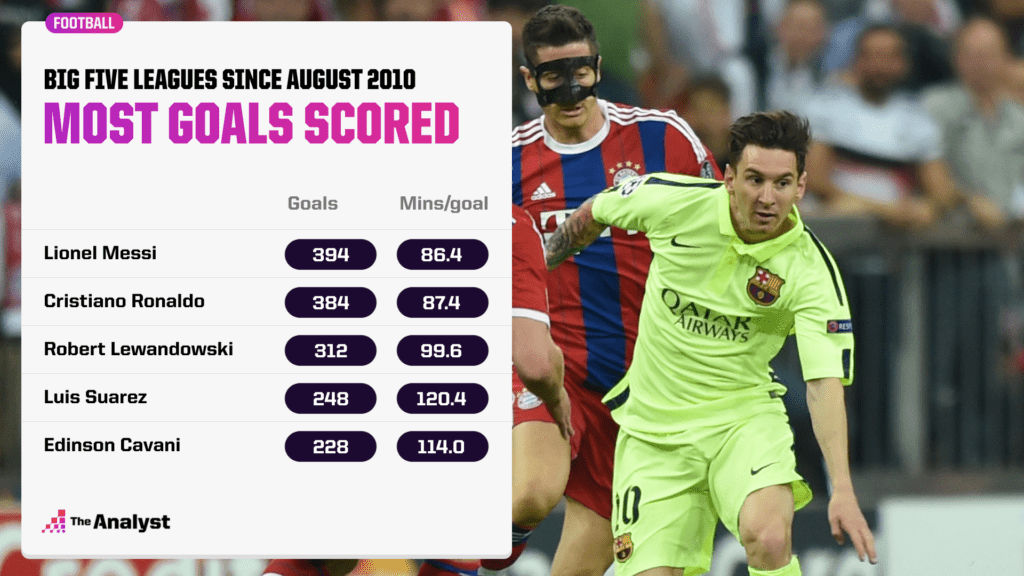
Between 2013-14 and 2021-22, 9,068 La Liga goals arrived at an average of 2.68 per game. That makes it the second lowest scoring of Europe’s top five leagues across those nine seasons, behind Ligue 1 (2.60 goals/game). By comparison, the Bundesliga was the highest scoring of the top five leagues over the same period, with an average of 2.99 goals/game. Indeed, in five of the nine campaigns concerned – including the last four – the German top flight produced a goals/game average of more than three – something which has otherwise only been seen in Serie A (in 2019-20 and 2020-21, for both of which Cristiano Ronaldo was at Juventus) since 2013-14.
Even in 2014-15 – when Ronaldo enjoyed the most prolific season of his career, amassing 48 league goals for Real, and Messi struck 43 times for Barça – La Liga’s goals/game average was a relatively low 2.65. It came closest to topping three in 2016-17 (2.94 goals/game) – when Ronaldo and Messi ‘only’ scored a combined 63 goals. The presence of machine-like marksmen such as Lewandowski and Erling Haaland alone doesn’t lead to the kind of goal-fests to which Bundesliga viewers have become accustomed to seeing on a regular basis; it needs the complementary, facilitatory ingredient of some – well – benevolent defending.
To the naked eye, the general standard of defending in Germany’s top division is the weakest in the top five leagues – and the data robustly backs that observation up. Going by expected goals against (xGA), in only one of the previous six seasons has the Bundesliga not been the weakest top five league defensively (2016-17 – although even then, the average team conceded a negligible 0.1 xG/game less than the average Serie A side).
Take nothing away from Lewandowski’s unquestionably terrifying quality in front of goal – something he’s reinforced with his scoring exploits in the Champions League (65 goals in 66 appearances) and at international level (only three European or South American players – Ronaldo, Messi and Pelé – have ever scored more international goals than the Poland captain’s 76) – but it would be remiss of us to overlook the environmental conditions, so to speak, of the league where he’s spent the past 12 years. As if to emphasise the Bundesliga’s enduring attacking fertility, Bayern kicked off their 11th successive title defence by thrashing Europa League winners Eintracht Frankfurt 6-1 last Saturday.
Despite the Bundesliga season being four games shorter than that of La Liga and Ligue 1, Lewandowski has outscored Messi for three successive league campaigns – 1.10 goals/90 (0.94 non-penalty) to 0.78 (0.62 NP) in 2019-20, 1.49 (1.2 NP) to 0.89 (0.8 NP) in 2020-21, and 1.06 (0.91 NP) to 0.25* (0.25 NP) in 2021-22 – but Messi is by far the better finisher, no two ways about it. And we can quantify the epoch-defining Argentine’s superiority in this department by assessing his and Lewandowski’s shooting goals added (SGA).
SGA gauges a player’s finishing ability by deducting the quality of their chances (xG) from the quality of the actual shots they take from those chances (expected goals on target [xGOT]). Messi has posted a positive SGA every season since 2013-14, with peaks of 8.95 overall in 2017-18 and 0.27/90 in 2018-19; Lewandowski recorded an SGA figure of 1.96 (0.06/90) in 2013-14 – his final campaign with Borussia Dortmund – but dipped below zero for his first five seasons at Bayern, before finishing with exactly zero in 2019-20, then 3.58 (0.13/90) in 2020-21 and 2.27 (0.06/90) in 2021-22.
Is it a surprise that Lewandowski is a significantly inferior finisher to Messi? It shouldn’t be – and, as much as we at The Analyst love it, we don’t need data to tell us that he’s still one of the finest finishers in the modern game. Just don’t expect a Messi-esque goals return from the guy who – nightmare-inducing though he may be for defenders and goalkeepers across the continent – is not the xGOAT.
*It’s fair to say Messi thoroughly underwhelmed during his debut campaign with PSG – but what better way to start the new season than with a deft, no-look flicked assist and a brace including the most casual of overhead kicks? He might be back…
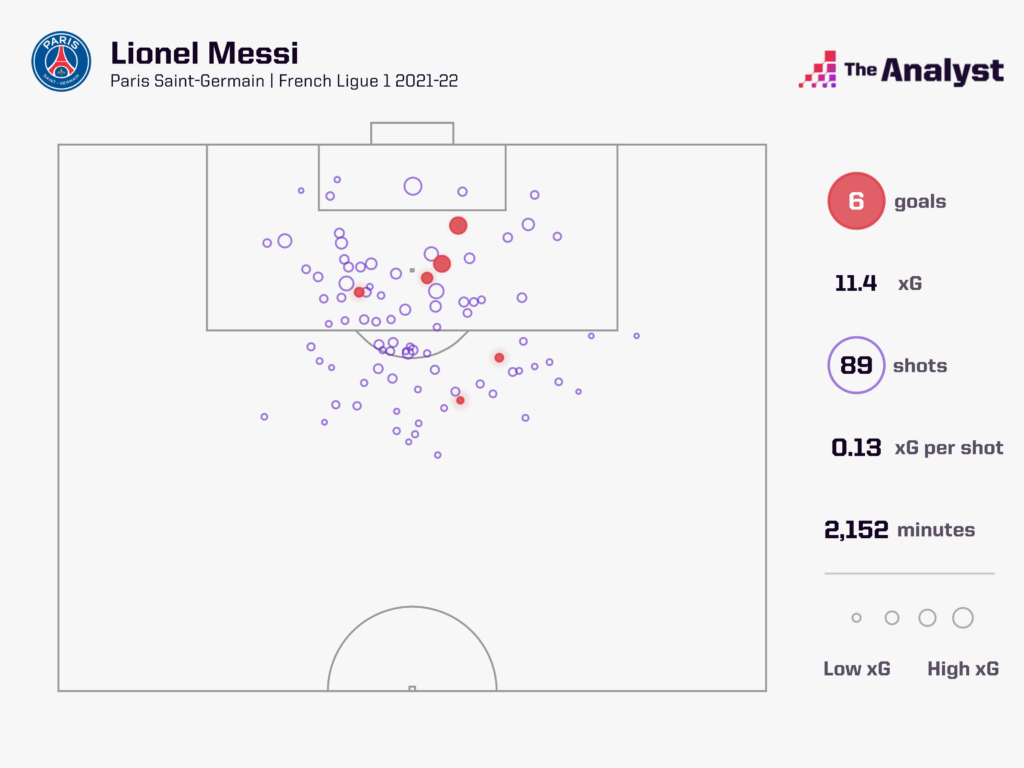
Lewandowski will be performing on a new stage – and, of course, he’ll have a new supporting cast alongside him. Having benefitted from the reliable service of Thomas Müller, Josh Kimmich and Serge Gnabry at Bayern in recent years, he’s joined a team who have at their disposal three of the most creative players in La Liga last term: Ousmane Dembélé, Ferran Torres and Jordi Alba.
When it came to big chance creation, no one ran Dembélé close. The Frenchman – who signed a new two-year deal with Barça last month – fashioned an average of 0.83 big chances / 90 in 2021-22, 0.3 more than Villarreal’s Gerard Moreno, the next highest-ranked player among those to play at least 900 minutes – and provided a league-high 13 assists from a league-high 9.25 expected assists (xA). Unfortunately, it’s far from a given that the injury-ravaged winger will stay fit – but if he does, Lewandowski could be laughing.
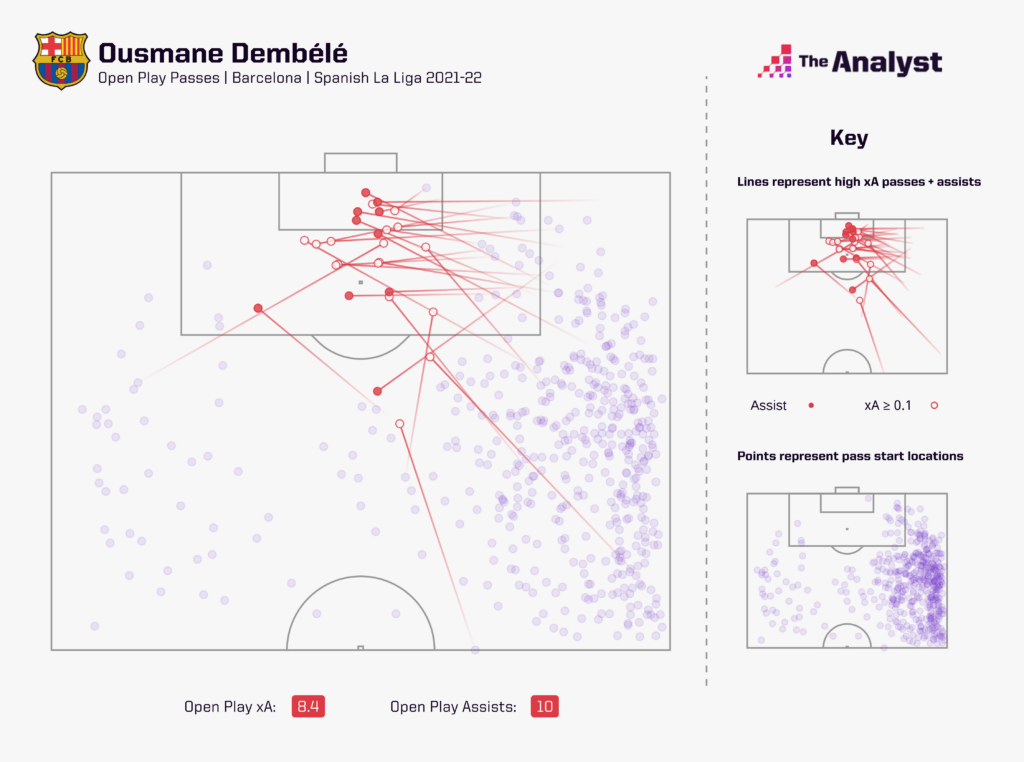
Joining Lewandowski in moving to the Camp Nou for 2022-23 is Raphinha – Barça’s most expensive signing of the summer at £55 million. Across 2020-21 and 2021-22, only seven Premier League players (Bruno Fernandes, Kevin De Bruyne, Harry Kane, Trent Alexander-Arnold, Mo Salah, Son Heung-min and Mason Mount) carved out more big chances than the Brazilian’s 22. A prospective Raphinha-Lewandowski-Dembélé front three (with Torres and Ansu Fati also attractive wide options) certainly has the feel of one which could get the 26-time champions of Spain – whose current three-season title drought is their longest since the early 2000s – back to where they believe they belong.
We can’t talk about creativity without mentioning Lewandowski’s own supreme space-creating skills – something upon which he might need to rely more than ever in the league of low blocks. At least he should know what to expect.
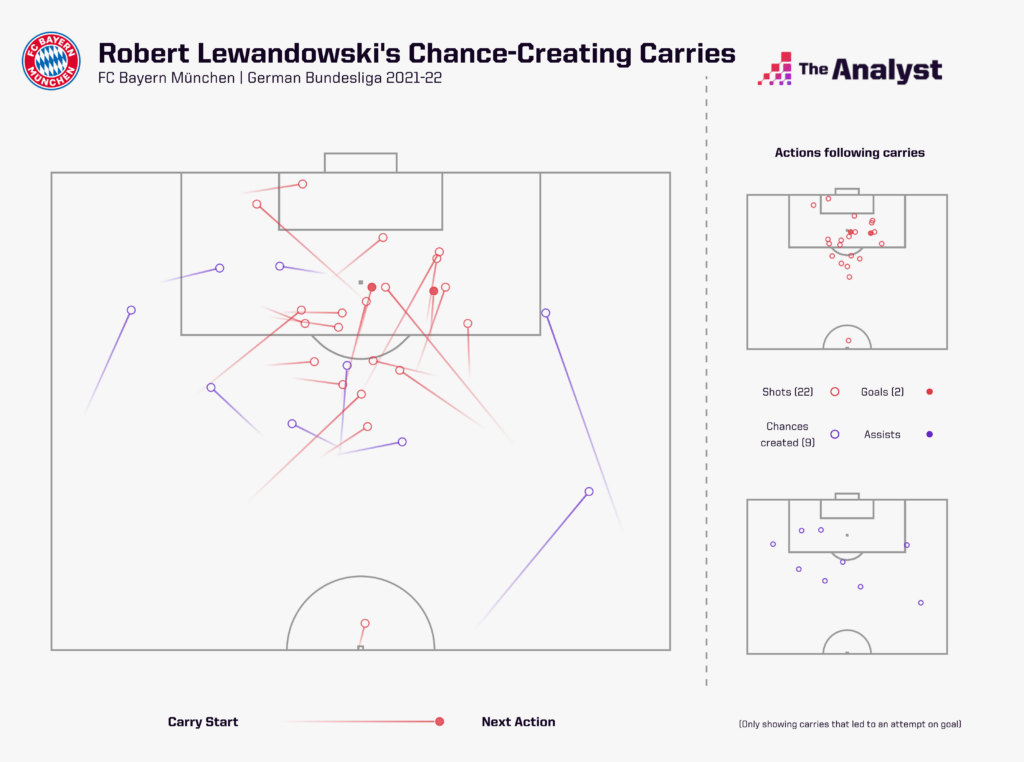
“It’s not easy for a striker when you play with six attack-minded players and the opposition defence sits so deep,” he admitted last year, discussing how Bundesliga opponents would try (and usually fail) to nullify his threat. “Of course, we carve out chances sooner or later, but it’s not so easy for me. Sometimes it’s tough, but I know I have to be patient.”
Such patience ought to stand him in good stead in La Liga, where he’ll be aiming to become just the fifth player from outside Western Europe or South America to finish as top scorer – after Samuel Eto’o, Hugo Sánchez, Hans Krankl and Ferenc Puskás.
